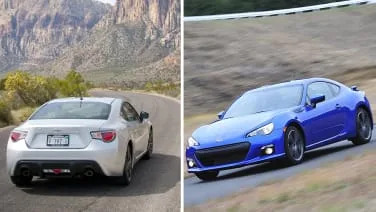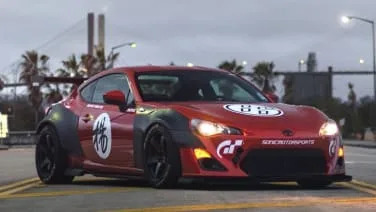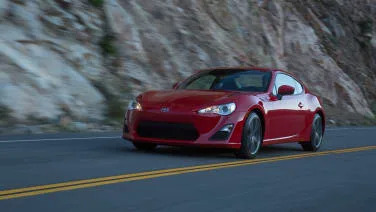2013 Scion FR-S
Don't look now, but the '80s are back. Thankfully, there's a bright spot among the nauseating resurrection of neon jeans, blue eyeshadow and shoulder pads: The return of the affordable Japanese sports car. And there's no better example than the 2013 Scion FR-S. But hold onto your parachute pants, because the FR-S is anything but dated. The front-engine, rear-wheel-drive coupe is all new, built in collaboration with Subaru, which, along with Toyota engineers, co-developed a flat 4-cylinder, horizontally opposed, direct-injection boxer engine. The two companies worked together to develop both the chassis and the small, lightweight engine with a shape and size that allows it to sit very low in the engine compartment, equating to a lower center of gravity (which Scion loves to point out is lower than the Porsche Cayman) for better balance and handling. Paired with a choice of a 6-speed manual or 6-speed automatic transmission, the 2013 Scion FR-S makes a respectable 200 horsepower and 151 pound-feet of torque.
Performance-oriented features abound on the 2013 FR-S, including a front MacPherson front suspension, a double-wishbone rear suspension, and ventilated disc brakes all around. Inside, the cargo area was configured, per a Toyota engineer's request, to fit four full-size tires and a jack with the rear seats folded flat. In other words, it's ready to head for the nearest autocross or track day event. Like other Scions, the FR-S is mono-spec with a plethora of optional a la carte accessories, including a cold air intake, big brake kit, sway bars, and body kit.
EPA fuel economy estimates for the 2012 FR-S are 22/30 mpg City/Highway for the manual transmission and 25/34 mpg for the automatic. All cars will be built alongside the Subaru BRZ, sister car to the Scion FR-S, out of Subaru's Gunma assembly plant in central Japan.
The primary inspiration for the FR-S was the 1983 Toyota Corolla, the fifth-generation of the Corolla, code-named AE86. Called the Hachi-Roku in Japan, the AE86 was a breakthrough sports car for Toyota. Its lightweight and high-revving engine powered the car to many track, rally and autocross wins. Toyota gives a nod to the AE86 with a stylized 86 on the FR-S badge. You may also notice the tailpipes measure 86 millimeters in diameter. Two other models influenced the FR-S as well: The 1965 Toyota Sports 800 and the 1967 Toyota 2000GT.
With that much of an homage to its history, some are left scratching their heads over why Toyota would brand the FR-S in the U.S. as a Scion. First, the Toyota brand image in North America these days evokes about as much excitement as a toaster. Consumers buy Toyotas for practicality and reliability, not so much for eye-catching design or breathtaking performance. Second, Scion, which boasts the youngest owners in the industry, needs a halo car, an attainable object of desire that draws new customers to a lineup of econo-boxes. But will it work? Scion execs think so. They anticipate the FR-S will appeal not only to teenagers …
Full Review
Full Review
But hold onto your parachute pants, because the FR-S is anything but dated. The front-engine, rear-wheel-drive coupe is all new, built in collaboration with Subaru, which, along with Toyota engineers, co-developed a flat 4-cylinder, horizontally opposed, direct-injection boxer engine. The two companies worked together to develop both the chassis and the small, lightweight engine with a shape and size that allows it to sit very low in the engine compartment, equating to a lower center of gravity (which Scion loves to point out is lower than the Porsche Cayman) for better balance and handling. Paired with a choice of a 6-speed manual or 6-speed automatic transmission, the 2013 Scion FR-S makes a respectable 200 horsepower and 151 pound-feet of torque.
Performance-oriented features abound on the 2013 FR-S, including a front MacPherson front suspension, a double-wishbone rear suspension, and ventilated disc brakes all around. Inside, the cargo area was configured, per a Toyota engineer's request, to fit four full-size tires and a jack with the rear seats folded flat. In other words, it's ready to head for the nearest autocross or track day event. Like other Scions, the FR-S is mono-spec with a plethora of optional a la carte accessories, including a cold air intake, big brake kit, sway bars, and body kit.
EPA fuel economy estimates for the 2012 FR-S are 22/30 mpg City/Highway for the manual transmission and 25/34 mpg for the automatic. All cars will be built alongside the Subaru BRZ, sister car to the Scion FR-S, out of Subaru's Gunma assembly plant in central Japan.
The primary inspiration for the FR-S was the 1983 Toyota Corolla, the fifth-generation of the Corolla, code-named AE86. Called the Hachi-Roku in Japan, the AE86 was a breakthrough sports car for Toyota. Its lightweight and high-revving engine powered the car to many track, rally and autocross wins. Toyota gives a nod to the AE86 with a stylized 86 on the FR-S badge. You may also notice the tailpipes measure 86 millimeters in diameter. Two other models influenced the FR-S as well: The 1965 Toyota Sports 800 and the 1967 Toyota 2000GT.
With that much of an homage to its history, some are left scratching their heads over why Toyota would brand the FR-S in the U.S. as a Scion. First, the Toyota brand image in North America these days evokes about as much excitement as a toaster. Consumers buy Toyotas for practicality and reliability, not so much for eye-catching design or breathtaking performance. Second, Scion, which boasts the youngest owners in the industry, needs a halo car, an attainable object of desire that draws new customers to a lineup of econo-boxes. But will it work? Scion execs think so. They anticipate the FR-S will appeal not only to teenagers …
Hide Full Review
Retail Price
| Engine | 2.0L H-4 |
| MPG | Up to 22 city / 30 highway |
| Seating | 4 Passengers |
| Transmission | 6-spd man w/OD |
| Power | 200 @ 7000 rpm |
| Drivetrain | rear-wheel |
| Curb Weight | 2,758 lbs |





